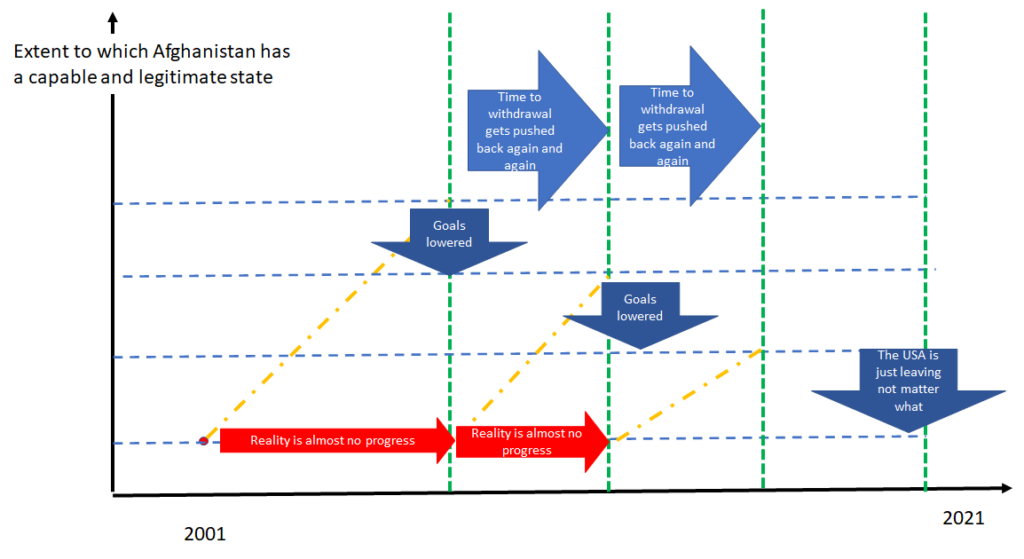After Poland and Germany, let’s pick an Asian country to understand better for the month of March. And given the recent deal that has been signed, about which more below, let’s begin with Afghanistan.
As always, begin with the basics. The gift that is Wikipedia, on Afghanistan:
“Afghanistan is a unitary presidential Islamic republic. The country has high levels of terrorism, poverty, child malnutrition, and corruption. It is a member of the United Nations, the Organisation of Islamic Cooperation, the Group of 77, the Economic Cooperation Organization, and the Non-Aligned Movement. Afghanistan’s economy is the world’s 96th largest, with a gross domestic product (GDP) of $72.9 billion by purchasing power parity; the country fares much worse in terms of per-capita GDP (PPP), ranking 169th out of 186 countries as of 2018.”
And from the same article…
The country has three rail links: one, a 75-kilometer (47 mi) line from Mazar-i-Sharif to the Uzbekistan border; a 10-kilometer (6.2 mi) long line from Toraghundi to the Turkmenistan border (where it continues as part of Turkmen Railways); and a short link from Aqina across the Turkmen border to Kerki, which is planned to be extended further across Afghanistan. These lines are used for freight only and there is no passenger service.
Now, as opposed to how I structured the essays on Poland and Germany, I intent to begin with the now and work my way backwards. This is primarily because of what Afghanistan is in the news for:
The joint declaration is a symbolic commitment to the Afghanistan government that the US is not abandoning it. The Taliban have got what they wanted: troops withdrawal, removal of sanctions, release of prisoners. This has also strengthened Pakistan, Taliban’s benefactor, and the Pakistan Army and the ISI’s influence appears to be on the rise. It has made it unambiguous that it wants an Islamic regime.
The Afghan government has been completely sidelined during the talks between the US and Taliban. The future for the people of Afghanistan is uncertain, and will depend on how Taliban honours its commitments and whether it goes back to the mediaeval practices of its 1996-2001 regime.
Doesn’t bode well for India, obviously, but doesn’t bode well for the United States of America either, says Pranay Kotasthane.
And the New York Times says a complete withdrawal of troops, even over the period currently specified, may not be a great idea. Ongoing support is, according to that newspaper, necessary:
More important than troops, potentially, is the willingness of the international community to continue to finance the Afghan government after a peace deal.
“The real key to whether Afghanistan avoids falling into an even longer civil war is the degree to which the United States and NATO are willing to fund and train the Afghan security forces over the long term,” Mr. Stavridis said. “When Vietnam collapsed and the helicopters were lifting off the roof of the U.S. Embassy, it was the result of funding being stopped.”
But it’s not just military funding! Afghanistan needs a lot of the world’s support in the years to come. Water, for example, will be a contentious issue in the years to come, and that’s putting it mildly.
Afghanistan doesn’t face a water shortage – it’s unable to get water to where it’s needed. The nation loses about two thirds of its water to Iran, Pakistan, Turkmenistan, and other neighbors because doesn’t harness its rivers. The government estimates that more than $2 billion is needed to rehabilitate the country’s most important irrigation systems.
And water, of course, is just one of many issues. Health, education, reforming agriculture, roads – it’s an endless list, and it will need all kinds of ongoing and sustained help.
So, amid all of this, what should India be doing?
Meanwhile, India’s interests in Afghanistan haven’t changed. India hopes to build up Afghanistan’s state capacity so that Pakistan’s desires of extending control can be thwarted. Given this core interest in a changed political situation, what’s needed in the long-term in the security domain is to build the strength of the Afghan National Defense and Security Forces (ANDSF). Without a strong ANDSF — which comprises the army, police, air force, and special security forces — peace and stability in Afghanistan will remain elusive. India’s aim should be to help the Islamic Republic of Afghanistan and ANDSF claim monopoly over the legitimate use of physical force.
But, the article presciently warns us of the same what/how problem we first encountered in studying the Indian budget:
In short, the budget might itself not be the biggest issue. The US has pumped nearly $3.6bn on average every year for the last 19 years solely on reconstruction of the ANDSF, a support that is likely to continue even if the US withdraws its soldiers. The bigger problems are insufficient processes to plan and execute budgets resulting in unused funds and lack of infrastructure leading to pay shortfalls.
Now, to unpack all of this, we need to study the following: the Soviet invasion and its aftermath, American involvement in the region, the rise of the Taliban, leading up to Operation Enduring Freedom, 2002. That’s next Wednesday!


